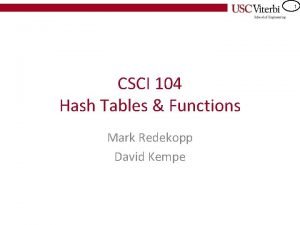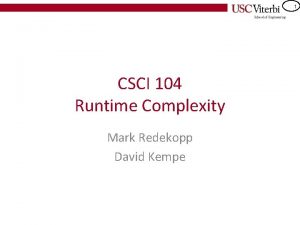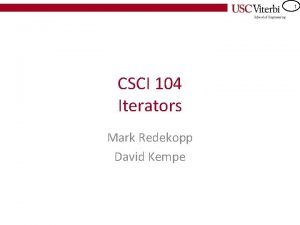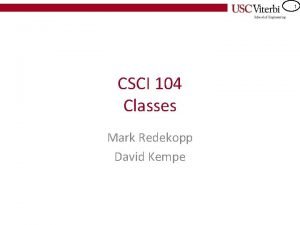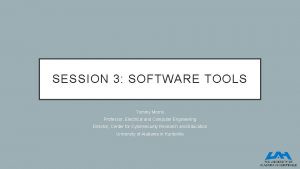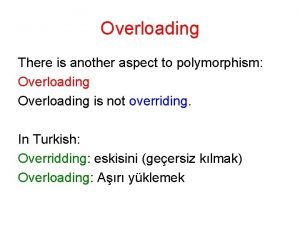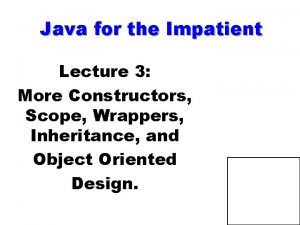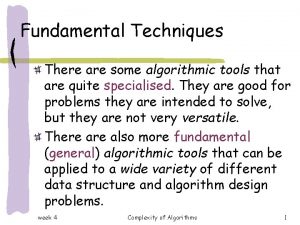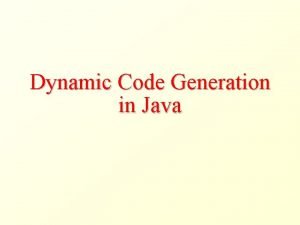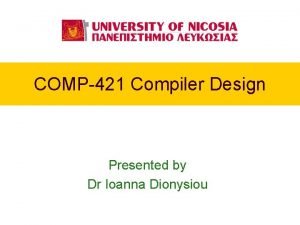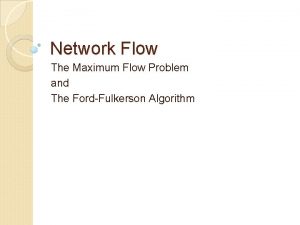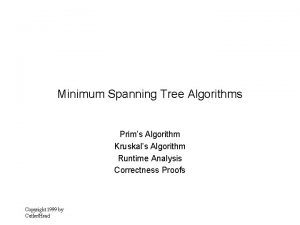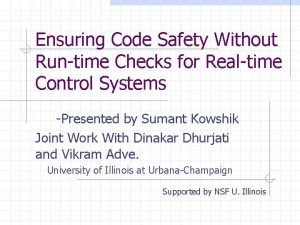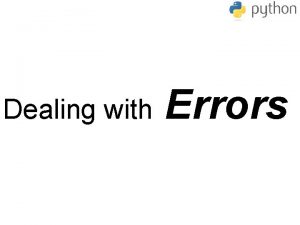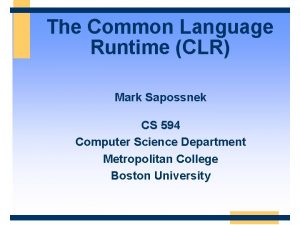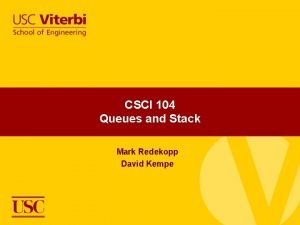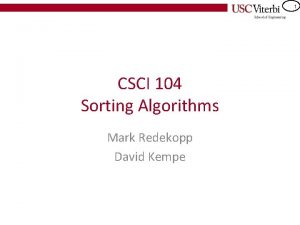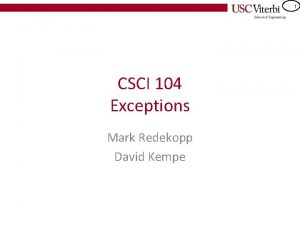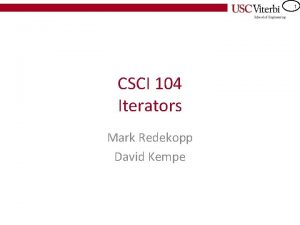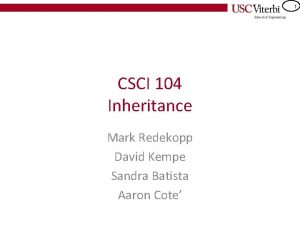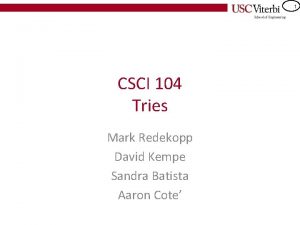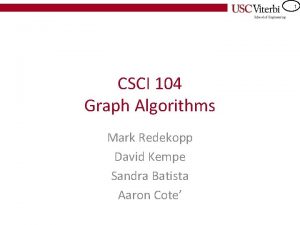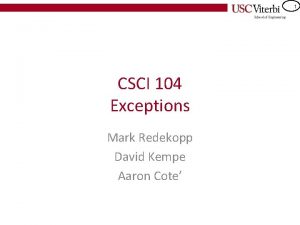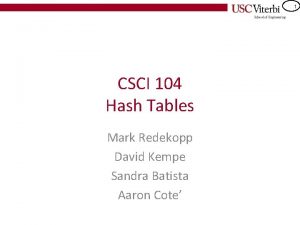1 CSCI 104 Runtime Complexity Mark Redekopp David




























- Slides: 28

1 CSCI 104 Runtime Complexity Mark Redekopp David Kempe

2 Runtime • It is hard to compare the run time of an algorithm on actual hardware – Time may vary based on speed of the HW, etc. • The same program may take 1 sec. on your laptop but 0. 5 second on a high performance server • If we want to compare 2 algorithms that perform the same task we could try to count operations (regardless of how fast the operation can execute on given hardware)… – But what is an operation? – How many operations is: i++ ? – i++ actually requires grabbing the value of i from memory and bringing it to the processor, then adding 1, then putting it back in memory. Should that be 3 operations or 1? – Its painful to count 'exact' numbers operations • Big-O, Big-Ω, and Θ notation allows us to be more general (or "sloppy" as you may prefer)

3 Complexity Analysis • To find upper or lower bounds on the complexity, we must consider the set of all possible inputs, I, of size, n • Derive an expression, T(n), in terms of the input size, n, for the number of operations/steps that are required to solve the problem of a given input, i head 0 x 148 0 x 1 c 0 0 x 168 3 0 x 1 c 0 9 0 x 168 2 0 x 0 (Null) val next – Some algorithms depend on i and n • Find(3) in the list shown vs. Find(2) – Others just depend on n • Push_back / Append • Which inputs though? – Best, worst, or "typical/average" case? • We will always apply it to the "worst case" – That's usually what people care about Note: Running time is not just based on an algorithm, BUT algorithm + input data

4 Big-O, Big- • T(n) is said to be O(f(n)) if… – T(n) < a*f(n) for n > n 0 (where a and n 0 are constants) – Essentially an upper-bound – We'll focus on big-O for the worst case a*f(n) • T(n) is said to be Ω(f(n)) if… – T(n) > a*f(n) for n > n 0 (where a and n 0 are constants) – Essentially a lower-bound T(n) • T(n) is said to be Θ(f(n)) if… – T(n) is both O(f(n)) AND Ω(f(n)) n 0

5 Worst Case and Big- • What's the lower bound on List: : find(val) – Is it Ω(1) since we might find the given value on the first element? – Well it could be if we are finding a lower bound on the 'best case' • Big-Ω does NOT have to be synonymous with 'best case' NOT synonymous – Though many times it mistakenly is • You can have: – Big-O for the best, average, worst cases – Big-Ω for the best, average, worst cases – Big-Θ for the best, average, worst cases

6 Worst Case and Big- • The key idea is an algorithm may perform differently for different input cases – Imagine an algorithm that processes an array of size n but depends on what data is in the array • Big-O for the worst-case says ALL possible inputs are bound by O(f(n)) worst-case ALL – Every possible combination of data is at MOST bound by O(f(n)) • Big-Ω for the worst-case is attempting to establish a lower bound (at-least) for the worst case (the worst case is just one of the possible input scenarios) – If we look at the first data combination in the array and it takes n steps then we can say the algorithm is Ω(n). – Now we look at the next data combination in the array and the algorithm takes n 1. 5. We can now say worst case is Ω(n 1. 5). • To arrive at Ω(f(n)) for the worst-case requires you simply to find AN input case worst-case AN (i. e. the worst case) that requires at least f(n) steps • Cost analogy…

7 Deriving T(n) • Derive an expression, T(n), in terms of the input size for the number of operations/steps that are required to solve a problem • If is true => 4 • Else if is true => 5 • Worst case => T(n) = 5 #include <iostream> using namespace std; int main() { int i = 0; x = 5; if(i < x){ x--; } else if(i > x){ x += 2; } return 0; } 1 1 1

8 Deriving T(n) • #include <iostream> using namespace std; int main() { for(int i=0; i < N; i++){ x = 5; if(i < x){ x--; } else if(i > x){ x += 2; } } return 0; }

9 Common Summations •

10 Skills You Should Gain • To solve these running time problems try to break the problem into 2 parts: • FIRST, setup the expression (or recurrence relationship) for the number of operations • SECOND, solve – Unwind the recurrence relationship – Develop a series summation – Solve the series summation

11 Loops • #include <iostream> using namespace std; const int n = 256; unsigned char image[n][n] int main() { for(int i=0; i < n; i++){ for(int j=0; j < n; j++){ image[i][j] = 0; } } return 0; }

12 Matrix Multiply • = C * A B Traditional Multiply #include <iostream> using namespace std; const int n = 256; int a[n][n], b[n][n], c[n][n]; int main() { for(int i=0; i < n; i++){ for(int j=0; j < n; j++){ c[i][j] = 0; for(int k=0; k < n; k++){ c[i][j] += a[i][k]*b[k][j]; } } } return 0; }

13 Sequential Loops • Is this also n 3? • No! – 3 for loops, but not nested – O(n) + O(n) = 3*O(n) = O(n) #include <iostream> using namespace std; const int n = 256; unsigned char image[n][n] int main() { for(int i=0; i < n; i++){ image[0][i] = 5; } for(int j=0; j < n; j++){ image[1][j] = 5; } for(int k=0; k < n; k++){ image[2][k] = 5; } return 0; }

14 Counting Steps • It may seem like you can just look for nested loops and then raise n to that power – 2 nested for loops => O(n 2) • But be careful!! • You have to count steps – Look at the update statement – Outer loop increments by 1 each time so it will iterate N times – Inner loop updates by dividing x in half each iteration? – After 1 st iteration => x=n/2 – After 2 nd iteration => x=n/4 – After 3 rd iteration => x=n/8 – Say kth iteration is last => x = n/2 k = 1 – Solve for k – k = log 2(n) iterations – O(n*log(n)) #include <iostream> using namespace std; const int n = 256; int main() { for(int i=0; i < n; i++){ int y=0; for(int x=n; x != 1; x=x/2){ y++; } cout << y << endl; } return 0; }

15 Analyze This • Count the steps of this example? • T(n) = T(n-1) + n-1 • 0 + 1 + … + n-2 + n-1 • (n-1)*n/2 #include <iostream> using namespace std; const int n = 256; int a[n]; int main() { for(int i=0; i < n; i++){ a[i] = 0; for(int j=0; j < i; j++){ a[i] += j; } } return 0; }

16 • Analyze This for (int i = 0; i <= log 2(n); i ++) for (int j=0; j < (int) pow(2, i); j++) cout << j;

17 Another Example • for (int i = 0; i < n; i++) { cout << "i: "; int m = sqrt(n); if( i % m == 0){ for (int j=0; j < n; j++) cout << j << " "; } cout << endl; }

18 Another Example • for (int i = 0; i < n; i++) { cout << "i: "; int m = sqrt(n); if( i % m == 0){ for (int j=0; j < n; j++) cout << j << " "; } cout << endl; }

19 What about Recursion • Assume N items in the linked list • T(n) = 1 + T(n-1) • = 1 + T(n-2) • = 1 + 1 + T(n-3) • = n = O(n) void print(Item* head) { if(head==NULL) return; else { cout << head->val << endl; print(head->next); } }

20 Binary Search • Assume N items in the data array • T(n) = – O(1) if base case – O(1) + T(n/2) • • = 1 + T(n/2) = 1 + T(n/4) = k + T(n/2 k) Stop when 2 k = n – Implies log 2(n) recursions • O(log 2(n)) int bsearch(int data[], int start, int end, int target) { if(end >= start) return -1; int mid = (start+end)/2; if(target == data[mid]) return mid; else if(target < data[mid]) return bsearch(data, start, mid, target); else return bsearch(data, mid, end, target); }

21 AMORTIZED RUNTIME

22 Example • You love going to Disneyland. You purchase an annual pass for $240. You visit Disneyland once a month for a year. Each time you go you spend $20 on food, etc. – What is the cost of a visit? • Your annual pass cost is spread or "amortized" (or averaged) over the duration of its usefulness • Often times an operation on a data structure will have similar "irregular" costs that we can then amortize over future calls

23 Amortized Array Resize Run-time • What is the run-time of insert or push_back: – – If we have to resize? O(n) If we don't have to resize? O(1) • Now compute the total cost of a series of insertions using resize by 1 at a time • Each insert now costs O(n)… not good push_back(21) => 21 0 1 Old, full array 2 3 4 30 51 52 53 54 0 1 2 3 4 5 Increase old array size by 1 Copy over items 30 51 52 53 54 21 push_back(33) => 33 0 1 2 3 4 5 6 0 1 2 3 4 5 5 Increase old array size by 1 Copy over items 30 51 52 53 54 21 33 Resize by 1 strategy

24 Amortized Array Resize Run-time • What if we resize by adding 5 new locations each time • Start analyzing when the list is full… – 1 call to insert will cost: 5 – What can I guarantee about the next 4 calls to insert? • They will cost 1 each because I have room – After those 4 calls the next insert will cost: 10 – Then 4 more at cost=1 • If the list is size n and full – – Next insert cost = n 4 inserts after than = 1 each Cost for 5 inserts = n+5 Runtime = cost / insert = (n+5)/5 = O(n) push_back(21) => 21 0 1 Old, full array 2 3 4 30 51 52 53 54 0 1 2 3 4 5 6 7 8 9 Increase old array size by 5 Copy over items 30 51 52 53 54 21 Resize by 5 strategy

25 Consider a Doubling Size Strategy • Start when the list is full and at size n • Next insertion will cost? – O(n+1) • How many future insertions will be guaranteed to be cost = 1? – n-1 insertions – At a cost of 1 each, I get n-1 total cost • So for the n insertions my total cost was – n+1 + n-1 = 2*n • Amortized runtime is then: – Cost / insertions – O(2*n / n) = O(2) = O(1) = constant!!!

26 Another Example • Let's say you are writing an algorithm to take a n-bit binary combination (3 -bit and 4 -bit combinations are to the right) and produce the next binary combination • Assume all the cost in the algorithm is spent changing a bit (define that as 1 unit of work) • I could give you any combination, what is the worst case run-time? Best-case? – O(n) => 011 to 100 – O(1) => 000 to 001 3 -bit Binary 4 -bit Binary 0000 001 010 0010 011 0011 100 0100 101 0101 110 0110 111 0111 1000 1001 1010 1011 1100 1101 1110 1111

27 Another Example • Now let's consider the program that generates all the combinations sequentially (in order) – – – – – • Starting at 000 => 001 : cost = 1 Starting at 001 => 010 : cost = 2 Starting at 010 => 011 : cost = 1 Starting at 011 => 100 : cost = 3 Starting at 100 => 101 : cost = 1 Starting at 101 => 110 : cost = 2 Starting at 101 => 111 : cost = 1 Starting at 111 => 000 : cost = 3 Total = 14 / 8 calls = 1. 75 Repeat for the 4 -bit – 1 + 2 + 1 + 3 + 1 + 2 + 1 + 4 + … – Total = 30 / 16 = 1. 875 • As n gets larger…Amortized cost per call = 2 3 -bit Binary 4 -bit Binary 0000 001 010 0010 011 0011 100 0100 101 0101 110 0110 111 0111 1000 1001 1010 1011 1100 1101 1110 1111

28 Importance of Complexity N O(1) O(log 2 n) O(n*log 2 n) O(n 2) O(2 n) 2 1 1 2 2 20 1 4. 3 20 86. 4 200 1 7. 6 200 1, 528. 8 40, 000 1. 60694 E+60 2000 1 11. 0 2000 21, 931. 6 4, 000 4 4 40 0 1, 048, 576 #NUM!
 Csci 104
Csci 104 Mark redekopp
Mark redekopp Xkcd tommy tables
Xkcd tommy tables Mark redekopp
Mark redekopp Mark redekopp
Mark redekopp Mark redekopp
Mark redekopp Mark redekopp
Mark redekopp Mark redekopp
Mark redekopp Mark redekopp
Mark redekopp Mark redekopp
Mark redekopp Mark redekopp
Mark redekopp Space complexity of nested loops
Space complexity of nested loops Dr redekopp
Dr redekopp Sub division of run time memory
Sub division of run time memory Definition of system programming
Definition of system programming Scadabr openplc
Scadabr openplc Compile time polymorphism java
Compile time polymorphism java Kinect for windows runtime
Kinect for windows runtime What is a constructor in java
What is a constructor in java Heapify runtime
Heapify runtime Matrix multiplication time complexity
Matrix multiplication time complexity Runtime error index out of bounds
Runtime error index out of bounds Generations code loader
Generations code loader Source language issues in compiler design
Source language issues in compiler design Ford fulkerson runtime
Ford fulkerson runtime Prims algorithm runtime
Prims algorithm runtime Basic runtime checks
Basic runtime checks Value error
Value error Microsoft common language runtime native compiler
Microsoft common language runtime native compiler

